Site menu:
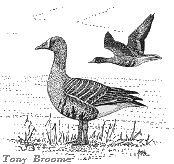
February 2010 Newsletter
West Kirby Marine Lake, Goldeneye and Red-breasted Mergansers.
Submission of 2009 Records.
January Bird News.
Forthcoming Events.
Latest Newsletter.
West Kirby Marine Lake, Goldeneye and Red-breasted Mergansers.
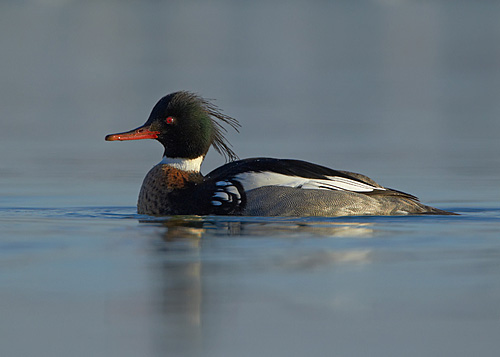
The Marine Lake
The lake was built in 1899 for people to boat on, and was doubled in size in 1987. Boats, of course, mean disturbance; but as that is the lake's purpose we shouldn't really complain when birds are disturbed, although that doesn't stop us! It is called a Marine Lake as it is filled with seawater and at spring tides regularly gets flooded as it is immediately adjacent to the Dee Estuary. At times when there is little or no wind, and therefore no sailing, it can attract good numbers of duck - mainly Goldeneye and Red-breasted Merganser. Although never a site to attract mega rarities or large numbers of birds it does have the advantage of having all round access to birders allowing for some wonderful views and good opportunities for photography. As well as the duck already mentioned we have seen Scaup, Pochard, Tufted Duck, Long-tailed Duck, both Whooper and Mute Swan, Shag, Great Northern Diver, Red-throated Diver, Great Crested Grebe, Glaucous Gull, Little Gull and Mediterranean Gull over the past few years, as well as one or two Leach's Petrels flying over during north-west gales. This last month (Jan 2010) was unusual as we had a prolonged period of very cold weather coupled with no wind, this meant inland waters were frozen and there was no sailing on the lake; consequently much larger numbers of ducks were present than what has been normal over the past few years. I thought it would be interesting to put the numbers of Goldeneye and Red-breasted Mergansers we saw into a historical context, as follows.
Goldeneye

Looking at Cheshire and Wirral Bird Reports going back as far as 1964 there have always been good numbers of this lovely duck on the marine lake, there was a max of 38 in 1964 which reached a high of 72 by the end of that decade. Counts have always been very variable, for example there was a max of only four in 1974 yet 40 the following year, 52 in 1983 dropped to only two in 1984. No doubt the amount of disturbance coupled with the weather will have had a big part to play in this variability.
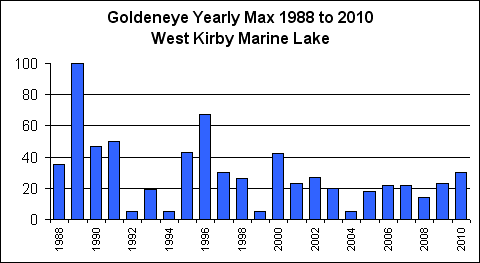
Although the 30 seen on 9th of January this year was the highest since 2000 historically it was nothing outstanding with seven years since 1987 exceeding it. With most, if not all, inland waters frozen over perhaps it is surprising we did not get more birds but no doubt there will have been many more on the sea. The highest ever recorded on the marine lake according to the Cheshire and Wirral Bird Reports was 'up to 100' in 1989 during an exceptional extended period of calm weather when no wind surfing was possible. That must have been quite a sight!
Red-breasted Merganser

Although large numbers were recorded on the Dee Estuary during the 1960s and 1970s (max 250 off Caldy in 1965) this species seemed to be virtually unknown on the marine lake at this time. 19 in 1977 was regarded as 'exceptional' and even by 1985 18 was regarded as 'an unusually large flock'. After the lake was extended in 1987 there were no records until 1993 when a high count of 43 was recorded. As can be seen in the graph below since then max numbers varied from year to year but never bettered the 1993 count until we got 46 on Jan 11th this year. When I saw them the majority were in one big flock although I missed what others saw, birds cooperatively fishing by herding the fish into the lake wall. Usually numbers aren't large enough for this fascinating behaviour.
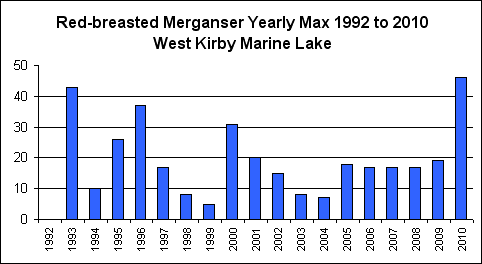
I find it a bit of a puzzle as to why there were such large numbers of Red-breasted Merganser last month, this species is almost exclusively marine in the winter so would not have been affected by iced over fresh water. May be they were attracted by the presence of the other ducks together with the nice flat calm water and complete lack of disturbance for several days, and there must have been plenty of fish! Although the count of 46 was higher than any recorded in the Cheshire and Wirral Bird Reports (i.e. since 1964) it appears not to be a record high count. Eric Hardy reported in The Birds of the Liverpool Area that birds were frequent on the lake before the second World War with 'about 50' in Dec of both 1937 and 1938.
There was one other species of duck in good numbers on the marine lake last month, Tufted duck - which reached 29 on Jan 10th. Normal yearly max of this largely fresh water species is just two or three. But 29 is tiny compared with inland numbers with 500 at Woolston Eyes in Cheshire a fairly typical number and 135 were on Shotwick Boating Lake in January 2009. Our small flock of 29 soon disappeared, this was before the thaw so it is interesting to speculate where they, together with the inland flocks, went to - presumably a lot further south!
Sources of Information for this Article:
1. Cheshire/Cheshire and Wirral Bird Reports 1964 to 2008.
2. David Cabot, Wildfowl, New Naturalist Library, 2009.
3. Eric Hardy, The Birds of the Liverpool Area, MNA Handbooks, 1941.
4. Records sent directly for inclusion on this Website (www.deeestuary.co.uk).
Submission of 2009 Records
Firstly, all the records which are NOT County rarities which are sent to myself (Richard Smith) for inclusion into this website are sent on and included in the Cheshire & Wirral and North-East Wales data bases, and these are then sent to the compilers when writing the Bird Reports. Obviously, as I cannot fill in a rarity form for birds I haven't seen, I don't send in rarity details - you will have to do that yourselves! It is VERY IMPORTANT to fill a rarity form in and get your record accepted by the relevant rarity panel - otherwise your record will not be official and it will be lost to posterity.
Please feel free to submit your records directly,
that way you will get your name mentioned rather than being lumped in with
the 'Dee Estuary Website', but more importantly it would be greatly
appreciated if you could submit any additional records, including rarities,
as follows:
For submitting Cheshire and Wirral records, including rarities, see
details in the CAWOS website - www.cawos.org
- click on 'recording' then 'submission of records'.
For submitting for the North-East Wales area (Flintshire and
Denbighshire) see the Clwyd Bird Recording Group website -
www.cbrg.org.uk - and click on 'will
you help by submitting records'.
I should like to add that where you have managed to take a photograph of a bird which is a County Rarity, of whatever quality, please include it with the description. If the photo is of reasonable quality then that alone will often be enough to get it accepted. But please include any features of the bird which the photograph may have missed, together with details of behaviour, precise location etc.
January Bird News
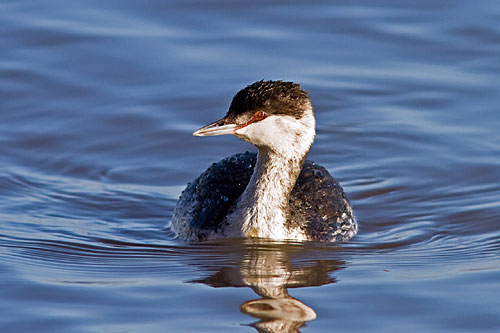
This Slavonian Grebe was one of two which came close into Flint Castle at high tide on the 1st. These weren't the only grebes to be seen as a massive 455 Great Crested Grebes were off Meols on the 4th. This large flock must be one of the largest in the country, but very difficult to count as they are so far out. 21 Scaup were present on the same day, much closer to the sea wall, with 39 off Hilbre on the 16th; an excellent count for this species. 62 Red-throated Diver were off Hilbre also on the 16th. A Velvet Scoter was off Hilbre on a couple of days as was an Eider and three Goosanders. As well as the ducks already mentioned in the above article West Kirby Marine Lake had a maximum of 13 Shags with two Common Pochard a rarity here.
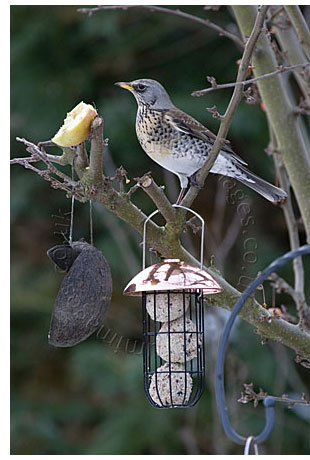
The big story of the month was the prolonged cold spell, like the rest of the country we had lying snow and freezing daytime temperature for several days - unusual for our normally mild maritime climate. During this spell we saw a marked influx of Woodcocks with 11 reported in just 12 days, normally we would expect just four a five reports a year. This species is very secretive so there is little doubt there would have been many more hiding in the woods and scrub. Fieldfares appeared to be everywhere with Redwings slightly less so. Bramblings also increased in numbers with a flock of 30 at Inner Marsh Farm. There were several days of crisp, sunny and windless days when it was a privilege to be down on the shore. I spent many hours at Thurstaston watching the Black-tailed Godwits (max 1,680), Knot (max 15,000) and Pintail (max 960). Towards the end of the month many Black-tailed Godwits started feeding in the nearby fields, by then ice free and presumably full of earth worms! Over 1,000 Black-tailed Godwits were also at Point of Ayr.
There were good numbers of Pink-footed Geese around. 600 or so are resident on the marshes of Neston and Parkgate, but we also saw many flocks passing through with 1,200 observed from Hilbre on the 10th the biggest flock reported. In this flock were 10 White-fronted Geese, a rare bird in our area, five were in a 'Pinkfoot' flock feeding on the Hoylake Langfields on the 19th. Brent Geese reached a max of 157.
A Shorelark was on the beach near Gronant towards the end of the month, and a single Snow Bunting further towards Point of Ayr. Two Snow Bunting were on the beach at Hoylake for a couple of days. A female Black Redstart was reported on the sea defences near Leasowe Castle on several dates, but was very elusive, another was on Burton Marsh on the 31st. Bitterns are always elusive but one showed well a few times at Inner Marsh Farm. Two Spoonbills were on Parkgate Marsh on the 9th, with a single seen at several locations throughout the month. Also at Parkgate have been the usual Short-eared Owls, up to five, and four Hen Harriers which included a 'grey' adult male. A female Marsh Harrier was seen on several times.
Richard Smith.
What to expect in February
The beginning of the month sees two very high tides predicted, given a decent
westerly wind these should result in the sea covering the marsh at
Parkgate and
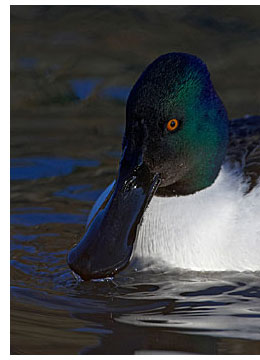 elsewhere. We should get some great views of Short-eared Owls in particular and
the several hundred Pink-footed Geese which are spending the winter here will
be brought a lot closer. Look out also for Hen Harriers, Water Rails and Jack
Snipe.
elsewhere. We should get some great views of Short-eared Owls in particular and
the several hundred Pink-footed Geese which are spending the winter here will
be brought a lot closer. Look out also for Hen Harriers, Water Rails and Jack
Snipe.
February usually has a day or two of mild weather bringing a foretaste of the spring to come, resulting in our woodland birds bursting into song as well as skylarks in full song in the sand dunes and fields. Other signs of spring might well be the arrival of Avocets, these will be on passage on their way north to Lancashire where good numbers now breed. A south westerly wind might well bring us our first Gannets of the year out to sea.
Wader numbers usually remain high through much of this month and we often get an influx of a few Spotted Redshank into Inner Marsh Farm and Connah's Quay. There will be several hundred Black-tailed Godwit off Thurstaston although numbers might well drop through the month as they seem to like going to East Anglia before making their long journey back to Iceland to breed.
Forthcoming Events
February Highest Spring Tides (Liverpool)
Also see
Tides page.
1st February, 12.30hrs (GMT), 10.1m.
2nd February, 13.14hrs (GMT), 10.0m.
3rd February, 13.57hrs (GMT), 9.8m.
Forthcoming Events
Organised by the
Wirral Ranger Service ,
Flintshire Countryside Service and/or the RSPB:
All these events and walks have bird interest, even those not advertised
specifically for birdwatching. No need to book for these events unless
specified - please check below.
Also see 'Wingspan', a Diary of Birdwatching
Events for Wirral and the North Wales Coast.
Monday 1st February, 11am start High Tide
at
Parkgate.
(10.1 metres)
Join RSPB wardens to watch the tide rise and possibly cover the
entire saltmarsh at Parkgate. Keep an eye out for the reserve's usual
suspects, such as Short-eared Owls, Hen Harriers and Merlins, as well as
hopefully seeing some of the more secretive species of birds and mammals
as they are forced out by the rising tide. Meet at Old Baths Car Park,
Parkgate. Ring 0151 336 7681 for further info.
Tuesday 2nd February, 11.30am start High Tide at
Parkgate (10.0 metres).
Another chance to join the RSPB Wardens at Parkgate for a birdwatch on a
big spring tide that might cover the whole of the saltmarsh.
Meet at Old Baths Car Park, Parkgate
Ring 0151 336 7681 for further info.
Friday 12th February, 8.30am start Lakeside Special.
Start the day in the company of the Rangers and RSPB for a wildlife walk
around the West Kirby Marine Lake. We’ll be looking for wintering Red-
breasted Mergansers and Goldeneye fishing on the lake and waders &
wildfowl feeding on the shore. Meet at the Morrisons end of South Parade.
Ring 0151 678 5488 for further info.
Sunday 14th February, 1.30pm – 3.30pm National Nestbox Week Kick-off.
It’s the first day of National Nestbox Week and to celebrate there will
be a
chance to make a nestbox with the Rangers or take advantage of sale
prices in the Green Shop. There’ll be heaps of free advice on where to
site your box for best results and feeding etc. Meet at the Visitor
Centre, Thurstaston. Ring 0151 648 4371
for further info.
Tuesday 16th February, 9.30am start Mud’n’Marsh.
Join the Rangers and RSPB Wardens on Heswall Shore for a high tide birdwatch.
An army of waders including battalions of Knot, Redshank & Dunlin are
pushed towards the marsh by the tide upon which flotillas of Shelduck and
Pintail meet. No need to book, meet at Banks Rd car park, Lower Heswall.
Ring 0151 648 4371 for further info.
Wednesday 17th February, High Tide
Birdwatch at Flint.
10am start, high tide at 13.00hrs, 9.1m.
The Oakenholt saltmarsh is one of the most important areas on the Dee
Estuary – come along and discover thousands of birds in this fantastic
habitat. Wellies are a must. Binoculars and warm clothing recommended!
Meet at the Flint Lifeboat car park (next to Castle), no need to book.
Ring 0151 336 7681 for further info.
Sunday 21st February, 3pm start Raptor
watch at
Parkgate.
The Dee Estuary Nature Reserve is a vital wintering ground for many birds
of prey. Discover these impressive birds in their wild habitat, hunting
and roosting on the saltmarsh with help from staff and volunteers from
the RSPB.
Meet at the Old Baths Car Park, Parkgate. Ring 0151 336 7681 for info.
Wednesday 24th February, 9.30am start
Glorious Mud.
There are thousands of waders feeding on the rich mudflats off
Thurstaston Shore and numbers of
Pintail are starting to build up. Join the Rangers on a birdwatch along
this fabulous stretch of beach to get close up views of these special
birds. No need to book, meet at the Visitor Centre, Thurstaston. Ring
0151 648 4371 for info.
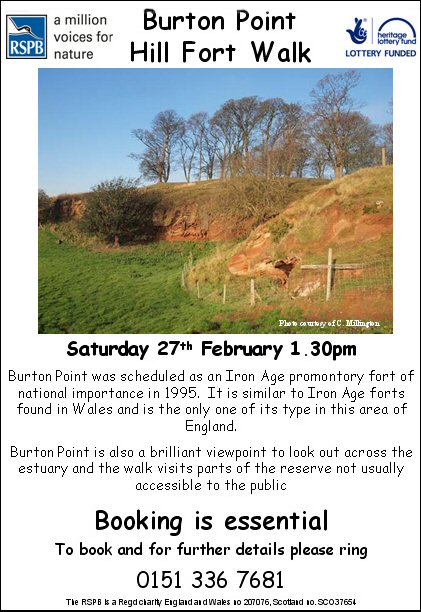
Monday 1st March, 10am start Marsh Matters – High tide at
Riverbank Road, Heswall.
Join the Rangers and RSPB Wardens at Riverbank Road car park to watch
thousands of birds gathering to roost in the marsh as the tide covers the
mudflats of the Dee Estuary. This activity may bring out some hunting
raptors. (High tide: 10.0m) Meet at Riverbank Road car park, Lower
Heswall. Ring 0151 648 4371 for info.
Tuesday 2nd March, 10.30am start High Tide
at
Parkgate (10.2 metres).
Join RSPB wardens to watch the tide rise and possibly cover the entire
saltmarsh at Parkgate. Keep an eye out for the reserve's usual suspects,
such as Short-eared Owls, Hen Harriers and Merlins, as well as hopefully
seeing some of the more secretive species of birds and mammals
as they are forced out by the rising tide. Meet at Old Baths Car Park,
Parkgate.
Ring 0151 336 7681 for info.
Wednesday 17th March, 9.30am Mud’n’Marsh -
St Patrick’s Day Special.
Join the Rangers and RSPB Wardens for a special birdwatch on
Heswall Shore. After watching thousands
of waders and wildfowl on the mudflats of the Dee Estuary retire to
Sheldrakes Restaurant for a bowl of Irish Stew and perhaps a pint of
Guinness?! Tickets are £5 and are limited in number. Ring 0151 648 4371
to book a place.
|
 |
The blank (UK) Birding Webring is a collection of quality birding web sites that are based in the United Kingdom. Visit the webring homepage for more information, or A complete list of all the sites in the webring is available by clicking here. previous site in ring : random site in ring : next site in ring |